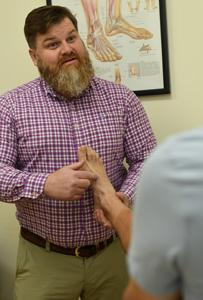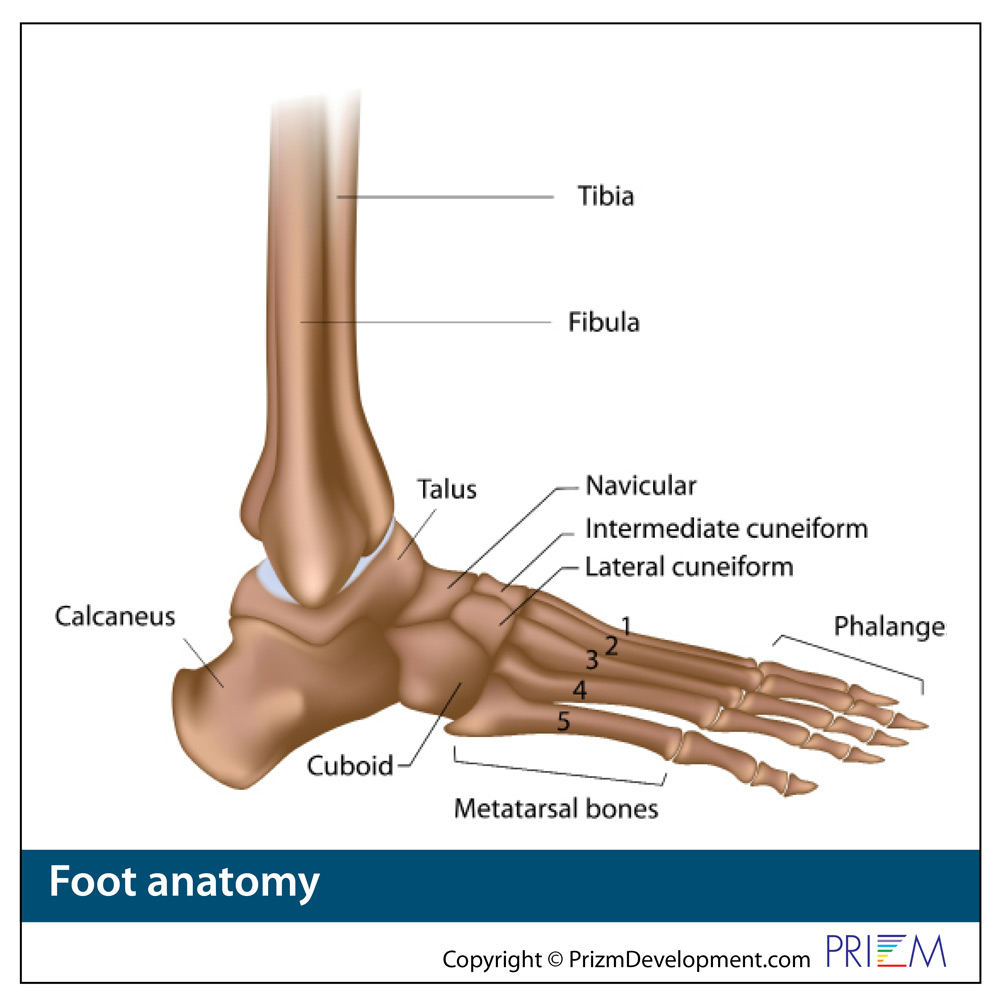Foot and Ankle Pain
![]() Our feet and ankles bear the brunt of every step we take. Women in particular wear uncomfortable, jarring yet fashionable shoes that can do damage to the structure of the foot over time.
Our feet and ankles bear the brunt of every step we take. Women in particular wear uncomfortable, jarring yet fashionable shoes that can do damage to the structure of the foot over time.
Athletes are at risk of foot problems from traumatic injury, joint, tendon, or ligament problems.
Celebration Orthopaedics has physicians who specialize in treating foot issues, both surgically and nonsurgically, a team of therapists, and a prosthetic center for foot orthotics.
The most common foot problems are:
- Foot and ankle trauma/fractures
- Ligament sprains/tendonitis
- Achilles tendon problems
- Heel pain/plantar fasciitis
- Bunions, hammertoes or claw toes
- Ankle or foot arthritis
- Flat feet deformities
What causes foot pain?
The causes of foot pain can relate to traumatic injury, problems with shoes, weight, or other disease processes. The fact is, the feet take a lot of abuse.
Here are some of the common causes of foot problems:
Corns are hardened, painful and raised calluses, most often on the side of the little toe, usually caused by shoes that cramp the toes. A foot specialist can remove them if necessary.
Ingrown toenails can be extremely painful. These may need the attention of a foot specialist.
Plantar warts are caused by a virus and can make walking painful when they appear on the bottom of the foot. The foot specialist can remove these by freezing them off.
The Achilles tendon can be a source of pain behind the ankle. A foot specialist can help correct the strain.
 Heel Pain
Heel Pain
When walking, the heel absorbs the brunt of our body weight in each step. That is 60 tons for every mile walked! It should come as no surprise that it is the most common type of foot injury. Those who experience heel pain should stop the offending activity immediately an schedule and appointment with a physician, since when left untreated, heel pain can become chronic.
Pain on the back of the foot
When pain surfaces behind the heel, it is usually caused by shoes that fit too snugly in the back. Sometimes it results from running in shoes that are too tight in the heel and can also develop from walking around in everyday shoes that are too tight. The best thing to do to treat this type of injury is to use anti-inflammatory medication such as Advil, to ice the heel and to do exercises prescribed by your doctor to stretch out the muscles and ligaments that are in pain.
Pain on the bottom of the foot
The three most common heel injuries at the bottom of the foot are stone bruises, plantar fasciitis, and heel spurs.
A stone bruise, usually develops from stepping on a hard object and is literally a bruise just like you would find anywhere else on the body. However, unlike a bruise on the arm, where it is easier to keep it protected, unless you are planning on riding around in a wheelchair, the foot will be irritated with each step. The best treatment for a stone bruise is to curtail as much walking as possible until the injury heals.
Plantar fasciitis is usually the result of overuse, either from running too long without rest or jumping on the heel too much. Again, the best treatment for plantar fasciitis is rest. Also, your physician may be able to show you some stretches and exercises for the injury as well as prescribe heel pads to wear while walking.
If plantar fasciitis is left untreated for too long, a calcium deposit called a heel spur may grow on the heel. These very painful growths are treated the same way plantar fasciitis is treated.
Hammer toe and Claw Toe
Unfortunately, all those years of wearing high-heeled, fashionable shoes can catch up with you. Hammer toe or claw toe can develop in people for a variety of reasons, but generally, hammer toe stems from years of wearing confining shoes and a muscle imbalance while claw toe can be caused by confining footwear, alcoholism, or diabetes. Hammertoes occur when a toe bends up permanently at the middle joint.
So, what then qualifies as a confining shoe? Shoes that provide a narrow space for the toes to squeeze into. A shoe that fits this description could be a high heel shoe that allows the toe to slide to close to the front of the shoe, a shoe that is a size too small or too narrow at the toe.
In its early stages, hammer toe can be treated nonsurgically. Usually, by only wearing shoes that provide plenty of space in the toes and by doing certain toe stretches, symptoms can be alleviated. In more severe cases, surgery may be necessary.
For claw toe, similar stretches will be prescribed. In more severe cases, those with claw toe will need to find a shoe repair place to add more room in the toe or buy shoes that are made with toe pockets. Also, sometimes pads for feet are placed in the shoe to help alleviate pressure on the toe.
Bunions
Bunions are tender lumps near joints around the toes, especially the big toe. A bunion or osteophyte can be removed surgically to relieve pain and restore joint motion. They are caused by improper footwear and heredity, which are quite common and it is estimated that more than 50 percent of women have them. Adolescents can also suffer from bunions. A bunion occurs when the bones that comprise the big toe of the foot begin to bend outwards. If left untreated, it can be very painful and can lead to arthritis. There are several ways to treat a bunion nonsurgically, including using special padding and shoe inserts to alleviate pain. Loose fitting shoes may also help for comfort and anti-inflammatory medication can cause swelling to go down. Also, soaking the foot in warm water can temporarily lessen the pain. Sometimes surgery is necessary, and following surgery, the foot will be able to fit into any size shoe comfortably.
Preventive care for the feet: It starts with shoes
The fashion-savvy will find it disheartening to hear that when it comes to foot health, function, not fashion, is key.
Looks can be deceiving, and what may seem like an attractive shoe could in the long run cause an array of musculoskeletal problems, including foot, ankle, knee, hip, and spine injuries.
One of the best ways to evade a foot injury is by wearing proper foot gear designed specifically for whatever activity you participate in with regularity. Runners should buy running shoes, basketball players (even weekend warriors) should buy basketball shoes, and the employee who constantly walk around for work should wear proper walking shoes. There is a shoe for virtually any activity.
Once you have decided it is time for a new shoe, there are several things to take into consideration to make sure you get the proper fit. For one thing, buy shoes at the end of the day. This is because the feet get larger the longer we stand on them, so at the end of the day, our feet will be larger than when we wake up in the morning. For athletes, the best thing to have is the sales person watch you walk and run in several shoes to see which provides proper support. A proper athletic shoe should leave enough room that there is a half-inch gap between the longest toe and the edge of the shoe. When in doubt, go up half a size. Shoes should NEVER feel too tight when you try them on. A proper shoe should not stretch out with wear.

 Foot & Ankle
Foot & Ankle